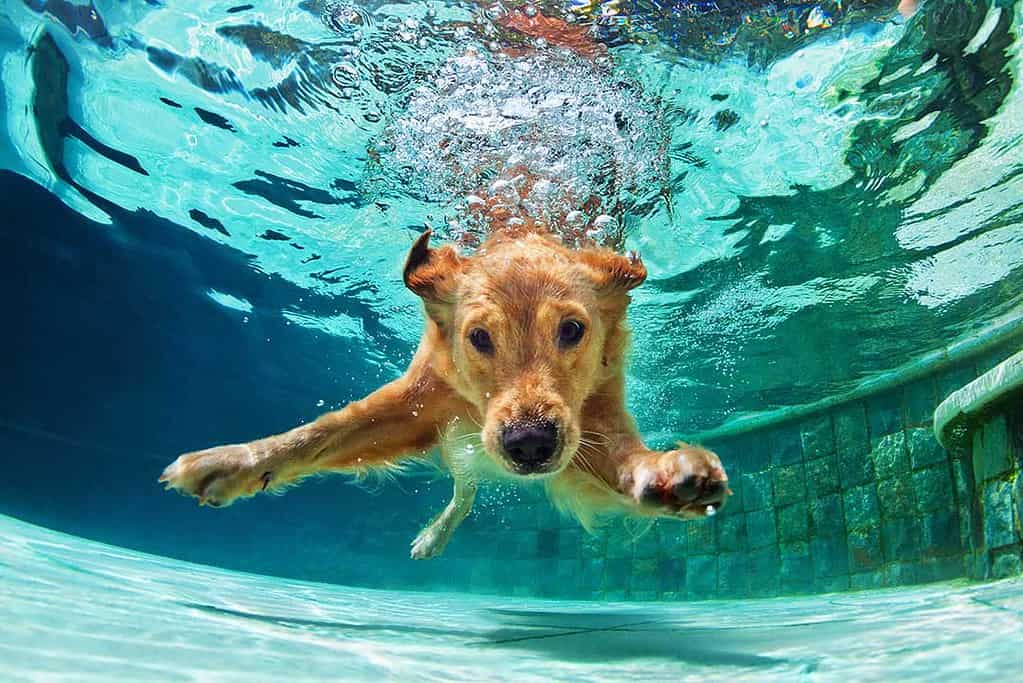Pets And Your Pool; Many dogs love to go swimming, especially in the heat of summer. If you have your own swimming pool, you might have considered letting your water-loving dog swim in it. Allowing your dog to swim in the pool is not an entirely bad idea, but there are some things you should consider first.
You and your family must decide whether to let your dog get into your swimming pool. The biggest factors to consider are safety and maintenance. Just like children, dogs must ALWAYS be supervised when swimming, even if it is a small backyard pool. We recommend if you have a pool and do not have it covered, always be outside when your dog is around the pool or has been let out to relieve itself.
Not all dogs are good swimmers, and if some dogs fall in, they cannot figure out how to get out or cannot swim well to do so. So, if you do decide to work on swimming with your dog, you must take things slowly and adapt to your dog. Some breeds cannot swim well. In addition, your dog's presence in the pool will change the way you need to maintain it. It will take extra time and work to make sure your pool chemical levels are appropriate, and your filtration system is in good working order.
A properly maintained swimming pool should be safe for dogs to swim in. Pool water, whether chlorine or saltwater, is not considered harmful under most circumstances. However, there are a few things to remember.
Everyone who swims ingests some amount of water. Kids and animals tend to swallow more than adult humans. Dogs simply do not know any better and may actively lap up the pool water. This should be avoided. Drinking pool water can lead to an upset gastrointestinal tract, leading to nausea, vomiting, and esophageal damage. In rare cases, drinking excessive amounts of pool water can cause a dangerous condition called water intoxication. This causes a major imbalance in the electrolytes in the body, leading to serious and potentially irreversible brain damage.
Pool chemicals can cause skin irritation and dryness in both humans and animals, especially if they swim often. Be sure to rinse your dog's coat after swimming and check the skin regularly for redness, flaking, or other issues. Contact your veterinarian if the skin appears abnormal.

Many pool experts say that one dog in a swimming pool will have the same effect on the pool water as three humans. This means that the amount of debris your dog brings into the pool is a lot more than what humans bring.
Dogs, of course, have a lot more hair than people. Any loose or dead hairs on your dog's coat will end up in the pool water, affecting the filtration system and the chemical balance. A dog's coat also tends to have a lot of debris like dirt, pollen, and even fecal matter that goes into the pool water when they swim. Parasites and germs can also contaminate the pool water and affect humans and other animals that enter the pool.
Dogs also have strong nails that can easily tear a pool liner if you own this type of pool. A suggestion is to keep your dog out of pools with plastic or vinyl lining. Nails can also be dangerous to other swimmers because of the way dogs use their paws to paddle in the water. In addition, their nails can easily damage pool toys and equipment.
You can reduce the negative effects your dog has on the swimming pool by keeping your dog clean and well-groomed. Trim your dog's nails regularly and keep them smooth. Bathe your dog regularly and brush out their coat well, especially if your dog sheds a lot. Before letting your dog get into the pool, brush his coat well, then rinse him off with water. This will cut down on the debris that he brings into the pool.
Remember to keep your pool clean and maintain the pool equipment to keep the pool safe for all swimmers. Also closely monitor the chemical balance so the pool water is properly treated.
Not all dogs are natural swimmers, so it is important to understand your dog's abilities before allowing him to swim. If you already know that your dog is a strong swimmer, then it is fine to let him jump in and enjoy himself, but never leave him unsupervised.
If your dog is new to swimming, gradually introduce him to the water. Never force him to get in the pool; instead, let him explore on his own. Consider getting him a life vest until you know he is comfortable swimming. Spend time in the pool helping him stay safe and comfortable but be careful about sharp nails that can easily claw at you.
Not all dogs are comfortable jumping in a pool or climbing steps to exit. Be sure to assist your dog, especially if your pool only has steps and ladders. A pool with a beach entry or shelf entry is much easier for dogs to enter and exit.
Make sure any pool cover in use is a safety cover and not a floating cover. Animals (and kids) can easily drown if they become trapped under a pool cover. Make sure when you let your dog out to potty and your pool is uncovered, you are always there to watch and ensure no dog falls in. Some dogs are not great swimmers or do not know how to get out, which can be a dangerous situation.